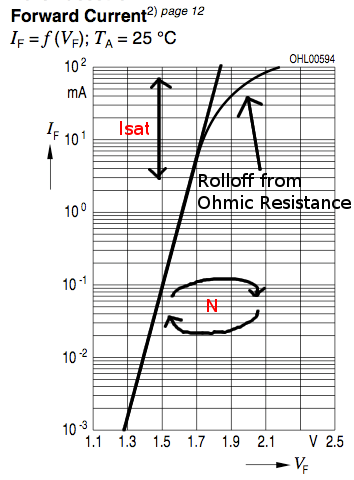What diode modifiers are used in practice to model LEDs with SPICE (Berkeley v.3f5)? These are available to me:
# Name Parameter Units Default Example Area
1 IS Saturation current A 1e-14 1e-14 *
2 RS Ohmic resistance Ω 0 10 *
3 N Emission coefficient - 1 1.0
4 TT Transit-time s 0 0.1ns
5 CJO Zero-bias junction capacitance F 0 2pF *
6 VJ Junction potential V 1 0.6
7 M Grading coefficient - 0.5 0.5
8 EG Activation energy eV 1.11 1.11 Si
0.69 Sbd
0.67 Ge
9 XTI Saturation-current temperature exponent 3.0 3.0 jn
2.0 Sbd
10 KF Flicker noise coefficient - 0
11 AF Flicker noise exponent - 1
12 FC Coeff. for for.-bias dep. cap. formula 0.5
13 BV Reverse breakdown voltage V ∞ 40.0
14 IBV Current at breakdown voltage A 1.0e-3
15 TNOM Parameter measurement temp. °C 27 50
3.4.2 Diode Model (D)
The dc characteristics of the diode are determined by the parameters IS and N. An ohmic resistance, RS, is included. Charge storage effects are modeled by a transit time, TT, and a nonlinear depletion layer capacitance which is determined by the parameters CJO, VJ, and M. The temperature dependence of the saturation current is defined by the parameters EG, the energy and XTI, the saturation current temperature exponent. The nominal temperature at which these parameters were measured is TNOM, which defaults to the circuit-wide value specified on the .OPTIONS control line. Reverse breakdown is modeled by an exponential increase in the reverse diode current and is determined by the parameters BV and IBV (both of which are positive numbers).
For example, using this basic, cheap red: 
![]()
I don't care much about high-frequency characteristics -- just would like to be able to match it's IV-curve within its operating specs (-10uA/-5V leakage to +100mA/+2.2'ishV forward):




